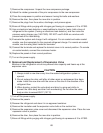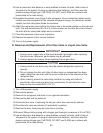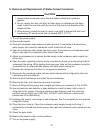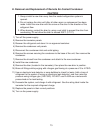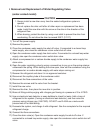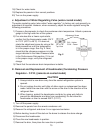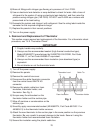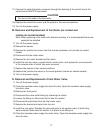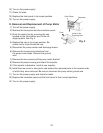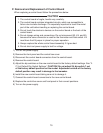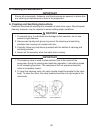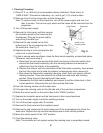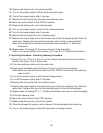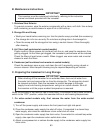
76
8) Braze all ttings with nitrogen gas owing at a pressure of 3 to 4 PSIG.
9) Use an electronic leak detector or soap bubbles to check for leaks. Add a trace of
refrigerant to the system (if using an electronic leak detector), and then raise the
pressure using nitrogen gas (140 PSIG). DO NOT use R-404A as a mixture with
pressurized air for leak testing.
10) Evacuate the system and charge it with refrigerant. See the rating label inside the
icemaker for the required refrigerant charge.
11) Replace the panels in their correct positions.
1) Turn on the power supply.
L. Removal and Replacement of Thermistor
This section covers removal and replacement of the thermistor. For a thermistor check
procedure, see "IV.E. Thermistor Check."
IMPORTANT
1. Fragile; handle very carefully.
. Always use the recommended sealant (high thermal conductive type),
Model KE4560RTV manufactured by SHINETSU SILICONE, Part Code
60Y000-11, or Part Code 4A0683-01 equivalent.
3. Always use the recommended foam insulation (non-absorbent type) or
equivalent.
4. Do not shorten or cut the thermistor leads.
1) Turn off the power supply.
) Remove the panels.
3) Remove the control box cover.
4) Disconnect the white thermistor connector
from the control board WHITE K3
connector.
5) Remove the plastic cable ties, foam
insulation, thermistor holder, and
thermistor. See Fig. 3.
6) Scrape away the old sealant on the
thermistor holder and the suction pipe.
7) Wipe off moisture or condensation on the
suction pipe.
8) Smoothly apply recommended sealant (KE4560RTV, Part Code 60Y000-11 or
4A0683-01) to the thermistor holder concave.
9) Attach the new thermistor to the suction pipe in the same position as the previous
thermistor. Be very careful to prevent damage to the leads. Secure it using the
thermistor holder and recommended foam insulation.
10) Secure the insulation using the plastic cable ties.
Foam Insulation Thermistor Holder
Thermistor Lead Cable Tie
Fig. 3



